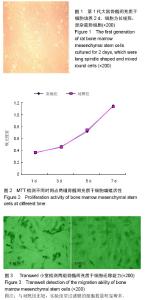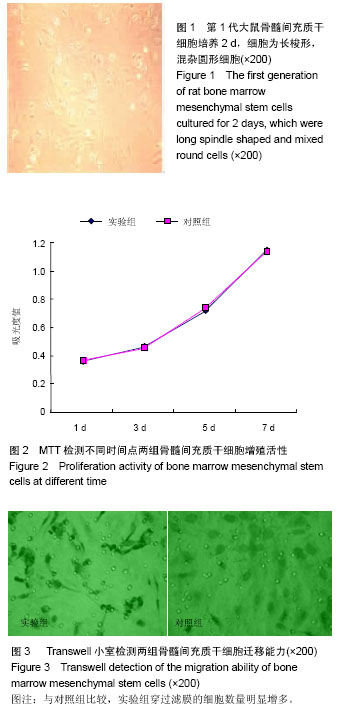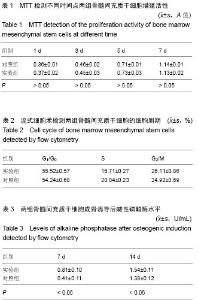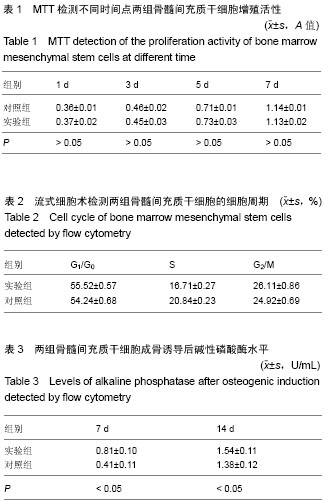| [1] 孙伟,李子荣,史振才,等.纳米晶胶原基骨和骨髓间充质干细胞复合修复兔股骨头坏死缺损的研究[J].中国修复重建外科杂志, 2005,19(9):703-706.
[2] 刘伟,艾合买提江•玉素甫,陈永峰,等. 筋膜包裹的骨髓间充质干细胞/聚己内酯复合体血管化组织工程骨修复比格犬骨缺损[J].中国组织工程研究与临床康复, 2010,14(7):1146-1151.
[3] 黎婷,孙晋虎,赵亮,等.骨髓间充质干细胞定向诱导分化成骨细胞移植修复腭裂骨缺损[J].口腔医学研究,2011,27(2):113-115.
[4] 付志杰,张巨峰,王大平,等.携带低氧诱导因子1α慢病毒感染大鼠骨髓间充质干细胞后成骨基因的表达[J].中国组织工程研究, 2014,18(28):4455-4462.
[5] 郝伟,姜明,王新,等.重组骨形态发生蛋白2、碱性成纤维细胞生长子共转染骨髓间充质干细胞复合纳米羟基磷灰石/重组类人胶原基/聚乳酸复合支架材料支架修复桡骨缺损研究[J].中华实验外科杂志,2013,30(5):1016-1019.
[6] 徐成振,杨文贵,何晓峰,等.血管内皮生长因子与纳米晶胶原基骨支架复合修复大鼠股骨缺损[J].中国组织工程研究与临床康复, 2011,15(38):7118-7122.
[7] 付志厚,王爱民.组织工程骨修复兔股骨髁骨缺损成骨效应的核素骨显像定量评价[J].中国组织工程研究与临床康复,2007, 11(23):4500-4503.
[8] 王浩,未东兴,王伟,等.异种去蛋白松质骨复合骨髓间充质干细胞修复骨缺损的组织学变化[J].中国组织工程研究与临床康复, 2011,15(51):9509-9512.
[9] 高志超,李善昌,金珊丹,等.骨髓间充质干细胞复合载异补骨脂素支架材料修复骨缺损的研究[J].口腔医学研究,2012,28(12): 1234-1238.
[10] 祝建中,苗宗宁,钱寒光,等.纳米晶羟基磷灰石与兔骨髓间充质干细胞复合培养回植体内的成骨性能[J].中国临床康复,2006, 10(41):195-197.
[11] 黎婷,刘爱良,孙晋虎,等.入骨髓间充质干细胞定向成骨诱导分化移植修复腭裂骨缺损的初步临床研究[J].中华临床医师杂志:电子版,2012,6(7):124-125.
[12] 赵琳,王栓科,董平,等.以小肠黏膜下层基质为支架复合骨髓间充质干细胞构建组织工程仿生骨膜:在兔体内的成骨及其血管化[J].中国组织工程研究与临床康复,2009,13(51):10079-10082.
[13] 李阳,房艳,柏树令,等.纳米“羟基磷灰石-胶原蛋白-壳聚糖”材料复合骨髓间充质干细胞修复小鼠胫骨缺损[J].解剖学报,2013, 44(3):386-392.
[14] 常玉立,孙天胜,刘智,等.自体骨髓间充质干细胞移植与纤维蛋白胶复合骨形态发生蛋白体内成骨的比较研究[J].中国康复理论与实践,2009,15(1):44-47.
[15] 刘星纲,梅芳,吕培军,等.纳米β-磷酸三钙/胶原复合兔骨髓间充质干细胞修复兔颌骨缺损的实验研究[J].中华老年口腔医学杂志,2012,10(6):325-328.
[16] Maijenburg MW, Kleijer M, Vermeul K, et al. The composition of the mesenchymal stromal cell compartment in human bone marrow changes during development and aging. Haematologica. 2012;97(2):179-183.
[17] 郝伟,姜明,周东生,等.rhBMP-2、bFGF双基因共转染兔骨髓间充质干细胞复合nHA/RHLC/PLA支架及其体内外成骨分化研究[J].中国矫形外科杂志, 2011, 19(13): 1130-1134.
[18] 田志逢,秦书俭,张小玲,等.不同接种密度骨髓间充质干细胞/骨基质明胶复合体修复大鼠桡骨缺损[J].中国组织工程研究与临床康复,2010,14(49):9126-9130.
[19] 孙伟,李子荣,王佰亮,等.磷酸三钙多孔生物陶瓷复合自体骨髓间充质干细胞修复股骨头坏死模型的超微结构观察[J].中国组织工程研究与临床康复,2009,13(3):457-460.
[20] Wang W, Li B, Li Y, et al. In vivo restoration of full-thickness cartilage defects by poly(lactide-co-glycolide) sponges filled with fibrin gel, bone marrow mesenchymal stem cells and DNA complexes. Biomaterials. 2010;31(23):5953-5965.
[21] Rider DA, Nalathamby T, Nurcombe V, et al. Selection using the alpha-1 integrin (CD49a) enhances the multipotentiality of the mesenchymal stem cell population from heterogeneous bone marrow stromal cells. J Mol Histol. 2007;38(5):449-458.
[22] 董平,焦虎,李秋晨,等.人骨髓间充质干细胞体外成骨与成脂分化过程中FGF1及其受体表达的变化[J].基础医学与临床,2013, 33(8):941-946.
[23] Mizuno D, Agata H, Furue H, et al. Limited but heterogeneous osteogenic response of human bone marrow mesenchymal stem cells to bone morphogenetic protein-2 and serum. Growth Factors. 2010;28(1):34-43.
[24] 段智霞,郑启新,郭晓东,等.骨形成蛋白2活性多肽体外定向诱导骨髓间充质干细胞向成骨方向分化的剂量依赖性研究[J].中国修复重建外科杂志,2007,21(10):1118-1122.
[25] 刘亚龙,武宇赤,刘国栋,等.DKK1在大鼠骨髓间充质干细胞成骨、成脂分化早期的差异性表达[J].中国骨质疏松杂志,2014,20(11): 1290-1297.
[26] 宗少晖,曾高峰,邹斌,等.小鼠骨髓间充质干细胞向成骨细胞分化过程中α-玉米赤霉醇对PINP和BMP-2表达的影响[J].广东医学, 2015,36(3):359-362.
[27] 赵东明,吴华,黄珊珊,等.电磁场激活细胞外信号调节激酶通路在骨髓间充质干细胞增殖与分化成骨中的作用[J].中华物理医学与康复杂志,2008,30(8):515-518.
[28] Liu T, Fu NN, Song HL, et al. Suppression of MicroRNA-203 improves survival of rat bone marrow mesenchymal stem cells through enhancing PI3K-induced cellular activation. IUBMB Life. 2014 Mar 23. doi: 10.1002/iub.1259. [Epub ahead of print]
[29] 宋丽华,黄燕,武翠玲,等.雌激素受体/一氧化氮/环磷酸鸟苷通路介导雌马酚逆转环孢素抑制骨髓间充质干细胞增殖及向成骨细胞的分化[J].中国组织工程研究与临床康复,2010,14(36):6833- 6836.
[30] In 't Anker PS, Noort WA, Scherjon SA, et al. Mesenchymal stem cells in human second-trimester bone marrow, liver, lung, and spleen exhibit a similar immunophenotype but a heterogeneous multilineage differentiation potential. Haematologica. 2003;88(8):845-852.
[31] Russell KC, Lacey MR, Gilliam JK, et al. Clonal analysis of the proliferation potential of human bone marrow mesenchymal stem cells as a function of potency. Biotechnol Bioeng. 2011;108(11):2716-2726.
[32] 方晔,宗少晖,赵劲民,等.α-玉米赤霉醇对小鼠骨髓间充质干细胞向成骨细胞分化过程中OPG和RANKL 蛋白表达的影响[J].中国骨质疏松杂志,2015,21(2):163-167,174.
[33] Wang W, Li B, Li Y, et al. In vivo restoration of full-thickness cartilage defects by poly(lactide-co-glycolide) sponges filled with fibrin gel, bone marrow mesenchymal stem cells and DNA complexes. Biomaterials. 2010;31(23):5953-5965.
[34] 李树宝,潘锋,白欣,等.壳聚糖介导真核双表达质粒pIRES-hVEGF121cDNA/hBMP-4转染兔骨髓间充质干细胞向成骨细胞分化[J].中国组织工程研究与临床康复,2009,13(1): 129-132.
[35] 景彩霞,刘昌奎,谭新颖,等.骨髓间充质干细胞与同种异体骨复合修复犬下颌骨缺损:成骨能力检测[J].中国组织工程研究,2015, 19(14):2138-2143.
[36] 王小志,何惠宇,杨楠,等.基因转染骨髓间充质干细胞复合同种异体骨修复绵羊极限骨缺损[J].中国组织工程研究,2013,17(47): 8141-8148.
[37] 韩冬,李建军,张巨,等.兔骨髓间充质干细胞向成骨方向的诱导分化及体内应用[J].吉林大学学报:医学版,2004,30(1):79-81.
[38] 李涛,宋国栋,包崇云,等.骨髓间充质干细胞作为干细胞参与生物材料异位诱导成骨[J].中国组织工程研究与临床康复,2010, 14(21):3819-3822.
[39] 刘晓阳,李广润,刘洪涛,等.硫酸钙人工骨/骨髓间充质干细胞构建组织工程化骨诱导脊柱融合[J].中国组织工程研究,2014, 18(21):3281-3286.
[40] 卜丽莎,李建军,韩东,等.重组PcDNA3.1-hBMP-2转染骨髓基质干细胞及复合异种骨支架体外构建组织工程骨[J].中国骨伤, 2004,17(8):449-451. |



